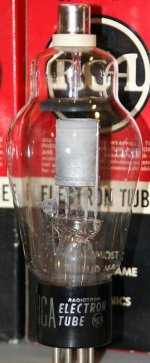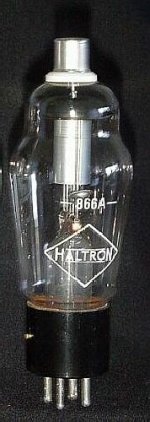Hello
I am looking for a trafo to supply the heaters on 2x866a
specs:
pri: 220v
sec: 2,5V ct 10amp
cant find any 220v version with the ct.. but is there a way to use a trafo without the ct? cant get my head around how i would connect it..
any help or link would be apreciated.
-Heinrich
I am looking for a trafo to supply the heaters on 2x866a
specs:
pri: 220v
sec: 2,5V ct 10amp
cant find any 220v version with the ct.. but is there a way to use a trafo without the ct? cant get my head around how i would connect it..
any help or link would be apreciated.
-Heinrich
Since it is a directly heated filament, simply pick off either filament connection. Makes no difference which side. A CT is not needed. Just make sure the transformer has the required insulation and current rating.
I guess I will be a spoiler and ask the obviously somewhat inexperienced OP why he wants to use 866A rectifiers.. 😛 They're certainly pretty to look at, but hazardous to have around if the envelope gets broken and the mercury gets out..
In addition there are certain practical considerations in their use such as:
In addition there are certain practical considerations in their use such as:
- A significant warm up time prior to the application of plate voltage to allow the mercury to fully vaporize so that they will not arc and destroy themselves.
- A need to run them with no plate power applied for up to 30 minutes or more depending on ambient temperature each and every time they are physically disturbed so that no internal shorts occur between electrodes. (And they arc and destroy themselves.. 😀)
- A propensity to generate a wide spectrum of RF noise. Good filtering and shielding is required.
- Choke input in most applications because they don't tolerate high peak repetitive currents very well despite their generous continuous current rating.
well... I must admit that i dont have any good reasons to use them...
but the reasons are:
a) They do look pretty
b) I wanted something different, then what the rest are using.
c) And the biggest reason is that i want something challenging.. it is for my first tube amp. a parallel push pull with 4x6550we, build as monoblocks. I know that i could have build a simple single ended amp (And i know that most people in here proberly think that i should have).
but i need the challenge to stay motivated.. and so i chose the 866a becourse it isnt easy to implement so I need to learn alot of new things to do it proberly (and safely)
and i know about the precautions, for starters Morgan Jones have a nice sections about them, and i have spent a long time reading and searching on the internet.
but yes i know it is kinda silly to use them, and that i should use the 3B28, og something like a 6d22s... 🙂
but the reasons are:
a) They do look pretty
b) I wanted something different, then what the rest are using.
c) And the biggest reason is that i want something challenging.. it is for my first tube amp. a parallel push pull with 4x6550we, build as monoblocks. I know that i could have build a simple single ended amp (And i know that most people in here proberly think that i should have).
but i need the challenge to stay motivated.. and so i chose the 866a becourse it isnt easy to implement so I need to learn alot of new things to do it proberly (and safely)
and i know about the precautions, for starters Morgan Jones have a nice sections about them, and i have spent a long time reading and searching on the internet.
but yes i know it is kinda silly to use them, and that i should use the 3B28, og something like a 6d22s... 🙂
There is yet another caution that pertains to NOS American made 866As with the larger bottle size from the 60s & 70s etc. This is compaired to the smaller size of European manufacture and later American types. See the sample pixs below. The older fat bottle types have a coating on the plate, and sometimes on the cathode shield too, that flakes off when heated. The flakes can, and very often do, get between the plate and cathode causing serious damage to the tube. It's like a small internal explosion. You can usually spot these tubes because there will be a slight orange-peel texture to the plate surface. Flaking happens rather quickly even as the mercury is vaporizing. This same problem is also common to the older 816s and 872s. Although I've never seen it with the European 866AX types with the screw on plate connectors.
Attachments
hmm... after reading #6, (didnt know that one...) and this thread which was new to me aswell.. http://www.diyaudio.com/forums/tubes-valves/183782-what-i-need-safe-use-mercury-rectifier.html well the thing about the mercury gas was new, didnt know that it was that dangerous compared to liquid mercury...
i am very close to go with the 3b28 instead.
i am very close to go with the 3b28 instead.
- Status
- Not open for further replies.
- Home
- Amplifiers
- Tubes / Valves
- Heater supply for the 866a

